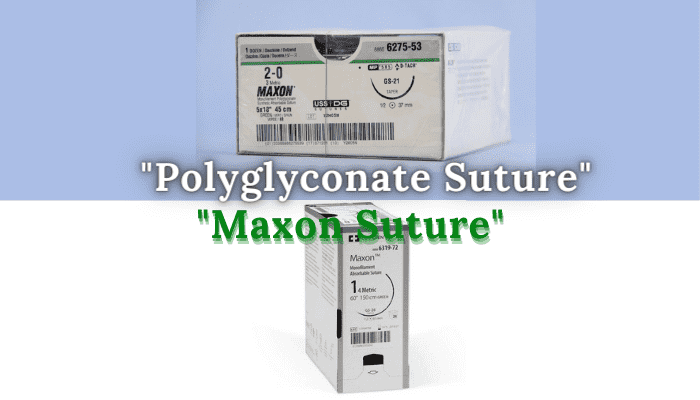Composition
Polyglyconate suture material is strong, synthetic, monofilament, absorbable copolymer of glyconates (eg. Monosyn: Braun) or combinations such as glycolic acid and trimethylene carbonate (1,3-dioxan-2-one) (Maxon: USS/DG). Trimethylene carbonate is a poly ester carbonate in nature and it is 32.5% by weight in polycarbonate.
Undyed polycarbonate is clear in appearance and dyed green for better differentiation during surgery. It is sterilized by ethylene oxide. They don’t have any coating. It is non-antigenic, non-carcinogenic in nature.
Tensile strength
Polyglyconate sutures have tensile strength similar to polydioxanone suture and have minimal tissue drag. Monosyn suture has quicker absorption and loses 50% of its tensile strength by 2-4 weeks so would be more suitable for subcuticular closure. Polyglyconate suture is easier to handle than polyglactin 910 and polypropylene sutures. The tensile strength (highest initial tensile strength – excellent in vivo strength retention) and absorption is dependent on the composition.
Knot Security
Polyglyconate sutures are stiff but have minimal suture memory and tend to conform tissues to suture rather than conforming to tissues. For good knot security extra throws should be placed, 5 throws to secure knot at start and 6-7 at end of continuous pattern. Knot security is better than PDS II suture, PGA and Polyglactin 910 suture.
Absorption
These sutures are absorbed by hydrolysis. Complete absorption of the suture takes 6-7 months.
Tissue reaction
It is minimally reactive and incites very less tissue reaction.
Indications
Polyglyconate / Maxon sutures can be used for linea alba closure. Like PDS sutures polyglyconates are also stable and retains tensile strength in alkaline environment which makes them suitable for use in biliary and urinary tract surgeries. But has less longevity in caine urine in comparison to PDS suture and chromic gut suture.
It can be used for most of the soft tissue surgeries, wound closures, esophageal anastmoses, intestinal anastmoses (in paediatric surgeries also), paediatric cardiovascular surgeries where growth is expected to occur, perispheral vascular surgeries, orthopaedic surgeries, gynaecological surgeries, bronchial and buried dermal sutures/subcuticular closures. Polyglyconate suture is superior to nylon and polybutester suture for tendon repairs. Polyglyconate suture is also indicated in the case of patients with compromised healing.
Polyglyconate suture is a better choice for fascia and abdominal wall closure in comparison to the PGA and Polyglactin 910 suture and also has higher tensile strength after implantation.
Contraindications
Use of polyglyconate / maxon suture is not indicated in adult cardiovascular surgeries, ophthalmic surgeries, microsurgeries, neurological surgeries, fixation of synthetic grafts and where extended tissue approximation is required.
Limitations
It is more economical than PDS sutures but handling characteristics have limited use in small animals. It is more difficult to handle in comparison to PSD.
Suture sizes
Available USP sizes are 7-0 to 2 with different types of needle and strand length.
Fig: Covidien Maxon Polyglyconate Suture (Clear/Undyed)
Fig: V-Loc Absorbable wound closure device – Polyglyconate Suture (Dyed Green)
FAQs
Maxon suture material is an absorbable synthetic suture prepared from copolymer of glycolic acid and trimethylene carbonate or polyglyconate.
Maxon sutures are completely absorbed in 180 days after implantation by hydrolysis.
Undyed maxon is clear in appearance and usually dyed maxon suture is green in colour.

Dear sir
how about polyglyconate material to make fishing line? could you please send me its specification and TDS?
thanks